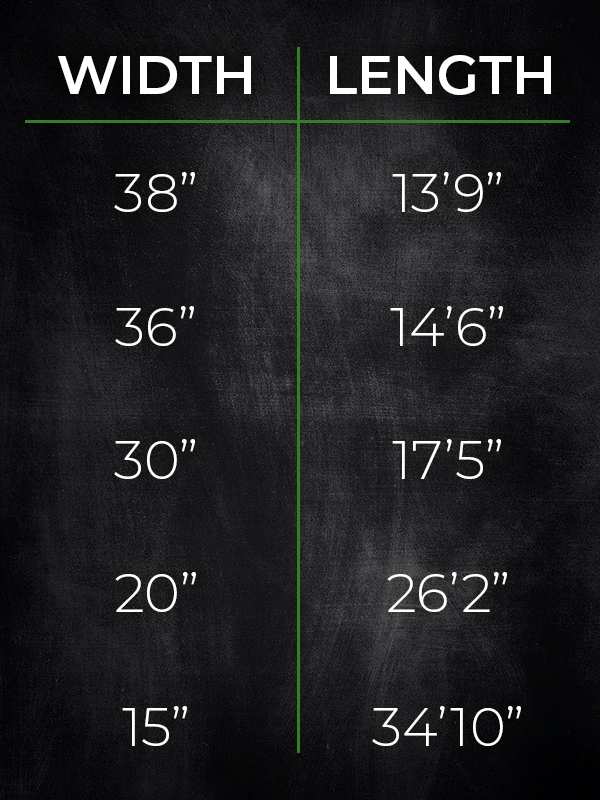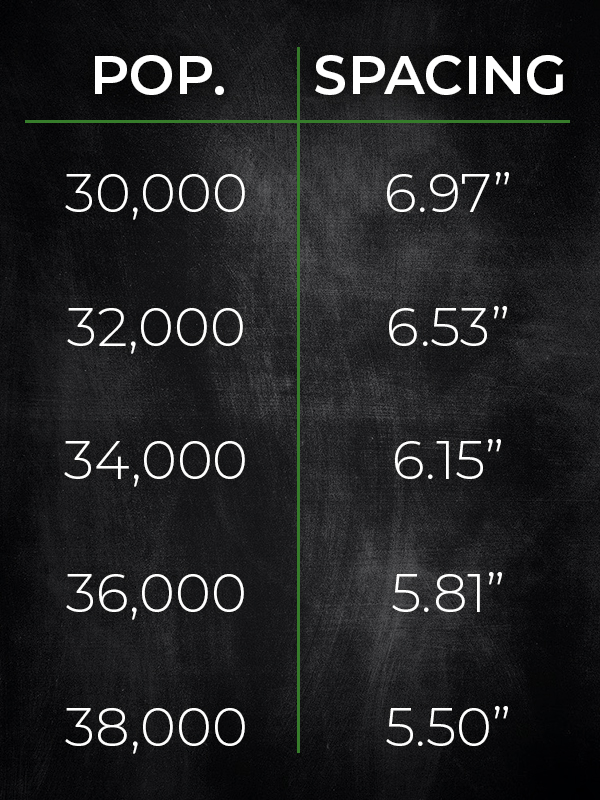
We’re back with another installment of the 2021 Seed to Grain Series, powered by Solutions 360! Now that planting is wrapping up for the year, it’s time to start evaluating our corn emergence. But what should we be looking for?
There’s actually several key points to check out in emerged plants, and no better time to evaluate them than now. When the corn is small, it’s easier to assess not only plant health, but also planter performance and weed pressure. Todd Farver, Van Wall Agronomist, gives you an in-field rundown in this video!

Stand counts are the #1 way to evaluate how both your planter and seed performed. Plus, uniform emergence can affect your yield by as much as 5-9% – so it’s time well spent! The first step in a successful stand count is measuring the right length of row. We’ve done the math for you and put together this handy chart of common row widths and the length of row you should use.
Once you pick a spot in the field to evaluate, lay out your tape measure alongside the plants and count how many emerged in the length of row that corresponds to your width. A perfect stand would come out to 1/1,000th of your target population. For example, our test plot was planted at 38,000 seeds/acre in 30″ rows. So, a perfect stand for us would be 38 plants in a 17’5″ length. Remember to take multiple stand counts across the field, then average them together to get an idea of actual performance.

While stand counts are easiest in fields that have a flat rate target population, they’re even more valuable in variable rate planted fields. By using the Operations Center mobile app, you can track your location while moving through the field to see what population you’re standing in, then continue with the stand count like normal. While you won’t be able to average together all of your stand counts (since the the target number may fluctuate heavily), you can instead turn your counts into ‘accuracy percentages’ to get a whole-field average. To do this, take each stand count number divided by the target – for example, let’s say our target was 38 plants, but we only counted 36. This would come out to 0.947, or 94.7% accurate. Do this math for all of your counts, then average together your percentages.
Key Takeaways
- Use stand counts to find out how successful your emergence was for both flat rate and variable rate planted fields.
- Average multiple stand counts together for a more accurate representation.
- Use the appropriate length of row for your row width.

Another great advantage to scouting just after emergence is the ability to identify skips in your rows. There are 2 main culprits behind skips: non-germinating seeds and planter adjustments.
While assessing your rows during stand counts, take the time to dig where you find skips and investigate why no crop emerged. Is there a seed that’s correctly placed, but no growth? If so, take a step back and look at the weather, soil conditions, and seed conditions at the time of planting and germination. There isn’t anything we can do now to fix a non-germinated seed, but taking the time to evaluate the whole picture may help in future planting decisions. If there is no seed present in the trench, then we know that a planter adjustment could be needed. Are there worn parts that need replaced? Was it an in-season adjustment that could have helped even out the spacing of that row unit? Asking yourself these questions early while the planting season is still fresh in your mind is the easiest way to make fixes for the future.

Since we’re already assessing skips in our stand count rows, why not double-check our spacing? This is by far the easiest time to measure the distance between corn plants, and is a great indicator of seed meters that need a tune-up. We dive into the math behind perfect spacing in our Part 2 Blog Post, but this chart gives you a quick go-to for common populations in 30″ rows.
Similar to stand counts, you’ll want to measure spacing between several sets of plants, then take an average to get a true picture of planter performance. If you have variable rate planted fields, use the accuracy percentage method instead of raw numbers. Uniform spacing actually has a 1-2% impact on your yield, and is an easy factor to check while scouting early in the season. Not sure how much variance is too much? Chat with your agronomist to determine what kind of yield impact you could be looking at.
Key Takeaways
- Dig in the trench of skip areas to find out where the problem is (i.e. seed or planter).
- Make adjustments to your planter (if needed) while the season is still fresh in your mind.
- While performing stand counts, check your average spacing performance.

Last – but most certainly not least – in our corn emergence evaluation checklist is weed scouting. When your corn plants are small, it’s easy to spot weed patches and begin identifying for treatment. Plus, the earlier you can eradicate weeds from your fields, the less nutrients will be robbed from your growing crop. There are 3 main points to hit when scouting: identification, treatment, and timing.
If you aren’t already, start making notes of common weed problems and areas that you see on your acres. Referring back to these notes each year is an easy way to prioritize your scouting and refresh your memory on past practices that were both successful and unsuccessful. And remember – scouting shouldn’t only happen at emergence! Revisit your fields throughout the growing season to stay ahead of weed, pest, & disease problems.
Some weeds are easier to identify early than others, but this handy guide from Iowa State University has pictures of common weed seedlings to compare against. If you aren’t sure or are on the fence about a weed, ask your local agronomist to confirm your ID so you can develop an accurate treatment plan that works and is cost effective.
Once you have your weed(s) identified, move on to choosing a chemical or tank mix to solve the problem. There is no end to the number of products on the market today, so take the time to chat with your agronomist and do some research to find your best fit. Spraying weeds with the wrong chemical can waste time and money, and contribute to resistance.
Now that you’ve chosen your chemical, it’s important to consider the timing of application. Chemicals may have different restrictions in respect to weed (and corn) growth stage, and applying outside of these windows can have a severe impact on your crop. The next big question on your mind should be whether replant is needed. If you spray now and replant later, make sure the resistance traits in the seed match up with what you sprayed and confirm whether the chemical has any residual window.
Key Takeaways
- Scout for weeds early in the growing season to minimize the nutrient impact on your crop.
- Make sure to verify your weed ID to choose the appropriate chemical.
- Check chemical restrictions to make sure you apply at the best possible time for effectiveness.
Be sure to follow us on social media and subscribe to our YouTube channel to be notified when Part 4 of the 2021 Seed to Grain Series is live!
Questions about how our Solutions 360 platform can make a difference on your operation? Contact our Precision Ag Support Team today to learn more!